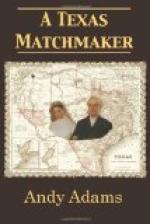Uncle Lance was in his element. Detailing two vaqueros to hold the beef cut within reach and a half dozen to keep the main herd compact, he ordered the remainder of us to enter and begin the selecting of beeves. There were a number of big wild steers in the round-up, but we left those until the cut numbered over two hundred. When every hoof over five years of age was separated, we had a nucleus for our beef herd numbering about two hundred and forty steers. They were in fine condition for grass cattle, and, turning the main herd free, we started our cut for the wagon, being compelled to ride wide of them as we drifted down stream towards camp, as there were a number of old beeves which showed impatience at the restraint. But by letting them scatter well, by the time they reached the wagon it required but two vaqueros to hold them.
The afternoon was but a repetition of the morning. Everything on the south side of the Nueces between the river and the wagon was thrown together on the second round-up of the day, which yielded less than two hundred cattle for our beef herd. But when we went into camp, dividing into squads for night-herding, the day’s work was satisfactory to the ranchero. Dan Happersett was given five vaqueros and stood the first watch or until one A.M. Glenn Gallup and myself took the remainder of the men and stood guard until morning. When Happersett called our guard an hour after midnight, he said to Gallup and me as we were pulling on our boots: “About a dozen big steers haven’t laid down. There’s only one of them that has given any trouble. He’s a pinto that we cut in the first round-up in the morning. He has made two breaks already to get away, and if you don’t watch him close, he’ll surely give you the slip.”
While riding to the relief, Glenn and I posted our vaqueros to be on the lookout for the pinto beef. The cattle were intentionally bedded loose; but even in the starlight and waning moon, every man easily spotted the ladino beef, uneasily stalking back and forth like a caged tiger across the bed ground. A half hour before dawn, he made a final effort to escape, charging out between Gallup and the vaquero following up on the same side. From the other side of the bed ground, I heard the commotion, but dare not leave the herd to assist. There was a mile of open country surrounding our camp, and if two men could not turn the beef on that space, it was useless for others to offer assistance. In the stillness of the morning hour, we could hear the running and see the flashes from six-shooters, marking the course of the outlaw. After making a half circle, we heard them coming direct for the herd. For fear of a stampede, we raised a great commotion around the sleeping cattle; but in spite of our precaution, as the ladino beef reentered the herd, over half the beeves jumped to their feet and began milling. But we held them until dawn, and after scattering them over several hundred acres, left them grazing




